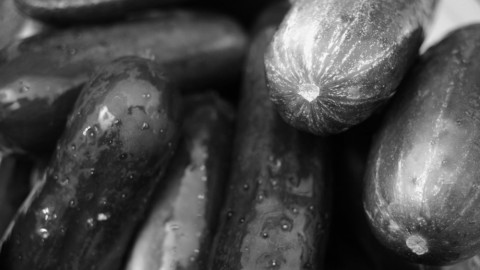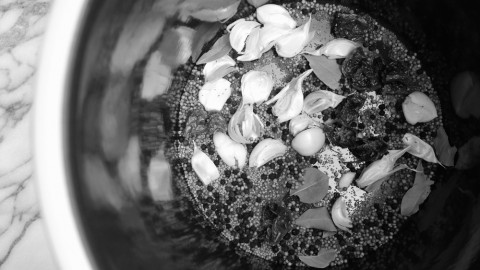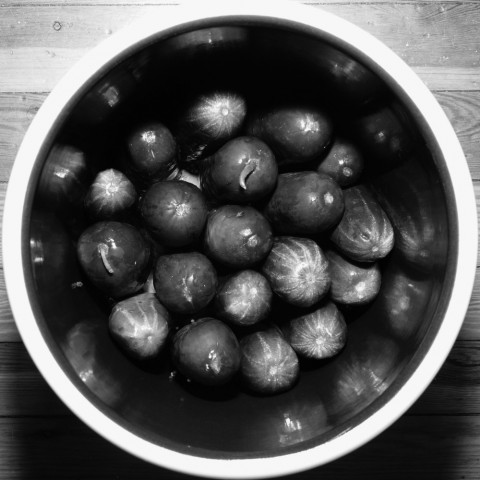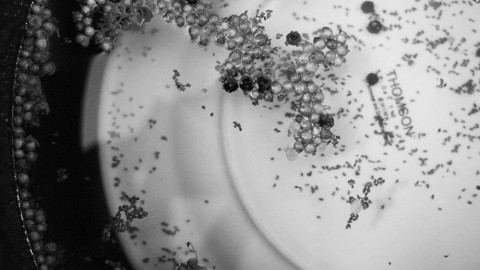I am tardy. Once again. In part because, over the past few weeks, my culinary focus has shifted away from recipes that are easily translated in words and pictures, and toward a massive experiment in — lacto-fermentation.
My friend (and urban forager extraordinaire) Hana got me onto it when I visited with her last month. She handed me a big fat book and told me, in no uncertain terms: you need to buy this. The book, it turns out, was Sandor Katz’s The Art of Fermentation. And she was right. I needed to buy it, and (enter shameless ad territory) so do all of you.
Katz’s book is not a recipe book (in the sense of having recipes in it), but rather a how-to manual that covers fermentations from pickles and sauerkraut to wild yeast beers, natto, and miso. It is in some part a guide to making fermented goodies, in some part an argument for their health and ecological benefits, and in some part a manifesto for a culture of post-Pasteur preservation.
Katz explains his (broad) definition of fermentation: anaerobic metabolism that transforms sugars into alcohol, sours pickles, etc. — but also adjacent culinary-relevant processes like the cultivation of a mother to make vinegar, and of molds to make tempeh. And then he makes a series of cogent and compelling arguments for why we should suspend any initial sense of revulsion at these processes, and jump in with both feet.
Of the environmental impact of food, he writes:
With fossil fuel supplies dwindling and requiring increasingly destructive extraction, rising global demand, and much uncertainty regarding availability, affordability, and safety of energy resources, we must consider the energy required by different foods. This means taking account of the energy embedded in the food’s growth and transport, as well as the energy we use in our homes for refrigeration and cooking…. Lactic acid ferments, on the whole, enable foods to enjoy some measure of stability outside of refrigeration. I regularly meet people who … live without refrigeration, and sauerkraut, miso, yogurt, hard cheese, and salami are among the kinds of foods these fridge-free folks eat. Envisioning a future where the refrigeration bubble could burst and average people could no longer afford to maintain refrigeration in the home, ferments such as these would become far more important.
Of the health benefits:
Fermented foods, as a group, are highly nutritious and digestible. Fermentation pre-digests foods, making nutrients more bioavailable, and in many cases fermentation generates additional nutrients or removes anti-nutrients or toxins…. As I write, the Proceedings of the National Academy of Sciences has just published exciting new research establishing that gut bacteria influence immune responses far from the intestines, and specifically that they are associated with “productive immune responses in the lung”…. In my own healing journey, I have found that live-culture foods help me feel good all around and give me a proactive way to help myself, as well as others. However, this does not mean that live-culture fermented foods are panaceas.
And his most important argument of all: As a rule, fermentation creates strong, compelling flavors.
I am, I will admit, yet a wild-fermentation neophyte. My experience making beers and meads has given me a good sense of how to proceed, and Katz’s book has filled in many of the gaps. But while I am providing a recipe here, please do recognize that it is provisional.
It is a recipe that I have constructed and tested, and with which I have had good results. The pickles that result from this recipe should taste a lot like the spicy refrigerator pickles I made a couple of months ago, but with a subtler sour, born of fermentation rather than a vinegar-based brine.
My pickles turned out well, but at this point, I can’t vouch for yours. The best I can do is suggest that you buy the book, and offer a couple of recommendations to get you started:
- Thoroughly clean your fermentation vessel, and all the utensils you plan to use. You want to give the lactobacillus that make ferments sour the best chance to out-compete other kinds of microbes.
- Don’t be scared when the brine goes cloudy, or when little islands of mold start to populate its surface. In the case of the former, it’s just lactic acid building up; and in the case of the latter, a clean spoon and good aim will alleviate the problem.
- Tannins keep your pickles crisp. So don’t ignore the teabags. They don’t add any flavor, but if you’re concerned, you can follow Katz’s advice and use fresh grape or oak leaves instead.
- Taste regularly. The only way you’ll ever figure out how long it takes for cucumbers to go all pickled in your environmental conditions, and to your liking, is through trial and error.
- Enjoy! Fermentation, as Sandor Katz makes obvious, is, if nothing else, a great culinary adventure. If things go wrong, nothing in this will make you more than passingly sick. And the worst that can happen is that you’ll be out a few dozen cukes.
20 Pickling Cucumbers
4.5 liters Filtered Water
200 grams Sea Salt
12 Cloves of Garlic, crushed but not peeled
6 Bay Leaves
3 Dried Habanero Peppers, cut in half
3 tbsp Coriander
2 tbsp Celery Seed
2 tbsp Black Pepper Corns
2 tbsp Mustard Seed
2 bags of black tea (high tannin content is key to making crisp pickles. Lipton may be best.)
In a stock pot over high heat, bring the water and salt to a boil, stirring until all the solids are dissolved. Turn the heat off, and allow the water to cool to room temperature, uncovered. This can be done the night before.
To your pickle crock (or other large vessel), add all of the pickling spices, including the garlic, peppers, and teabags. Thoroughly wash the cucumbers, making sure to scrub the blossom ends. Then pack them tightly — I kind of like vertically — into your crock.
Pour the brine over the cucumbers, filling the crock until all the solids are submerged. Weight down the cucumbers (I used a salad plate). Cover the crock loosely, and store it in a dark place.
You’ll want to check on the pickles periodically, skimming any mold colonies off the top of the brine, and examining the color (and flavor) of the cucumbers. Like I said, cloudy brine is (apparently) normal. And a little mold, so long as you’re diligent about skimming it, is (apparently) no problem either.
Depending on the weather and the size of the cucumbers, the pickles should be ready to eat in 1-3 weeks, at which point you may choose either to refrigerate them, or to allow them to continue to mature in the brine.




